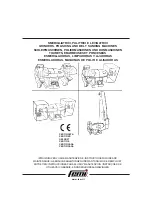
21
Adjusting the position of the gear housing
Unplug the supply cord from the mains supply. Clean the diamond cutter.
To facilitate working safely and comfortably in any position (On/Off switch accessible
from above), the gear housing can be adjusted to one of 4 positions (at 90° intervals).
Example:
Cutting using DC-D diamond cutting discs.
Remove the four screws. Rotate the gear hous-
ing through 90° without pulling it away from the
motor housing. Re-insert and retighten the screws
carefully. Screw the side handle (3) into the thread-
ed bushing.
Care and maintenance
Always disconnect the plug from the mains socket before carrying out any work on
the tool.
The cooling slots in the motor housing must be kept clean and unobstructed at all times.
Dust should be blown out from the motor at regular intervals (approx. every four weeks),
if possible using compressed air.
Conductive dust may collect inside the tool when it is used under extreme conditions
for working on metals. This may reduce the effectiveness of the tool's electrical insula-
tion. In such cases, the use of a stationary dust extraction system and a ground fault
interrupter switch (FI) are recommended. Dust should also be blown out from the ven-
tilation slots at frequent intervals.
The tool has been manufactured carefully and subjected to stringent tests and inspec-
tions. Nevertheless, should it become necessary, the tool should be repaired at a Hilti
service centre.
Repairs may be carried out only by trained electrical specialists.
The carbon brushes are of the automatic cut-out type. The tool will be switched off
automatically when it becomes necessary to replace the carbon brushes. Use only
original Hilti carbon brushes.
The tool requires no other maintenance.
Structural design considerations
Slits in load-bearing walls are subject to part 1 of the DIN 1053 standard, or other nation-
al regulations and directives.
It is essential that these regulations are observed. The design engineer, architect, or per-
son in charge of the building project must be consulted before beginning slitting work.
Environment
Only for EU countries
Disposal of electric tools together with household waste is not permissible!
In observance of European Directive 2002/96/EC on waste electrical and
electronic equipment and its implementation in accordance with national
law, electric tools that have reached the end of their life must be collected
separately and returned to an environmentally compatible recycling facility.
Most of the materials from which Hilti electric tools are manufactured can be recycled.
The materials must be correctly separated before they can be recycled. In many coun-
tries, Hilti has already made arrangements for taking back your old electric tools for
recycling. Please ask your Hilti customer service department or Hilti representative for
further information.
Return waste
material for
recycling
Printed: 07.07.2013 | Doc-Nr: PUB / 5069468 / 000 / 00



































